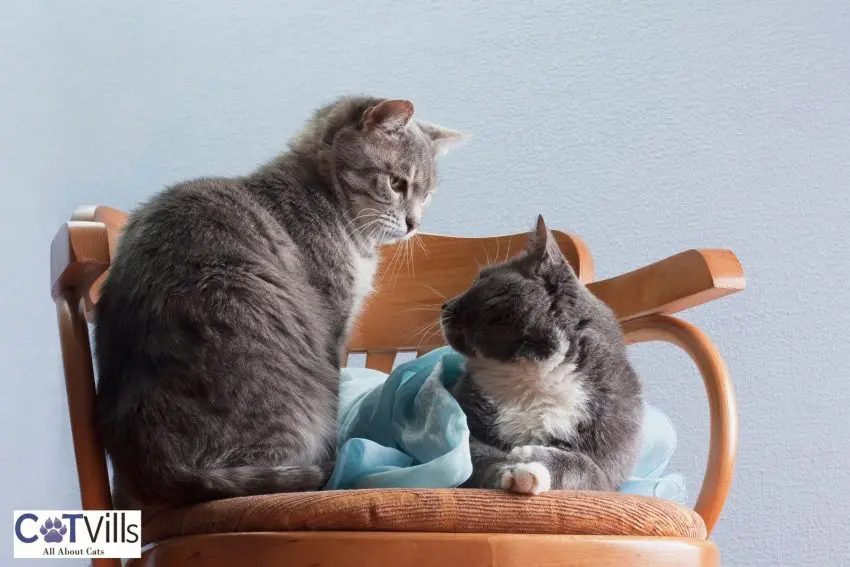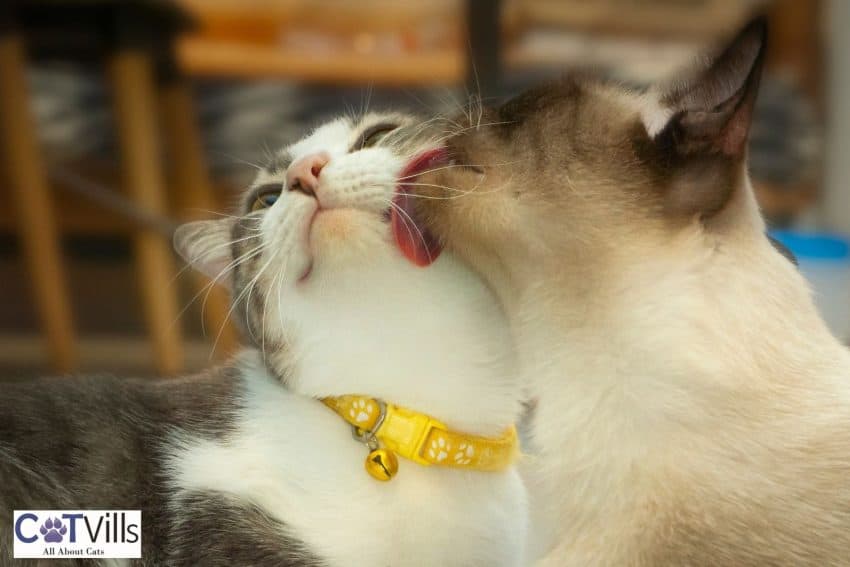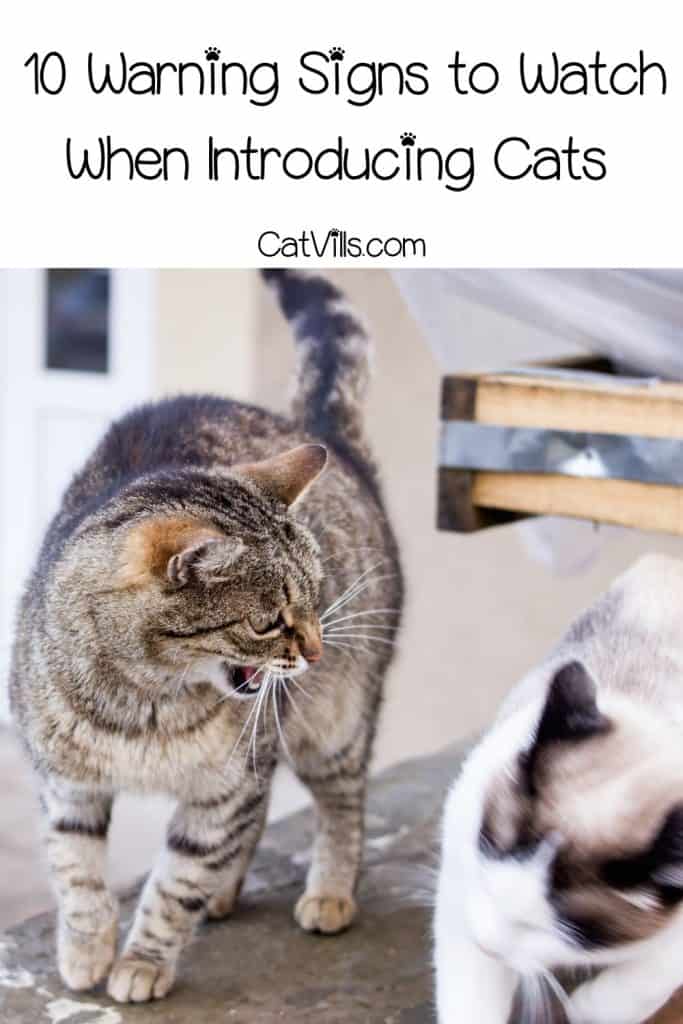Last Updated: 2 years ago
If you are bringing a new feline friend into a home where you already have a resident kitty, you need to know the warning signs when introducing cats.
Cats are territorial animals, and most of them prefer flying solo, so without a proper introduction, fur can fly!
To minimize the havoc wrought by feuding felines, a cat owner needs to be on the lookout for early red flags.
While a successful introduction can take time, it’s essential to carefully read the body language in the initial meeting to avoid a catastrophe!
Warning Signs To WATCH when introducing two cats

73% of the time, aggressive cat warning signs between two cats start when they are introduced
In fact, a study shows that hostile behavior in the first meeting is the biggest predictor of fighting.
Once started, conflict tends to stay the same for about half of multi-cat households because many owners struggle to know what to do after the initial introduction.
To avoid aggressive behavior and a stressful household, it’s vital to make a proper introduction. Introducing an adult cat to a new cat should take place over a period of time in order to be successful.
But before we get to that initial meeting, the cat owner needs to know the signs of aggression in feline social interactions so that they know when to intervene.
#1 Staring

Everybody knows that cats love to sit on the lap of the one person who isn’t a cat lover or has an allergy.
This is because, to most animals, a direct stare with a lot of eye contact is a sign of aggression.
Think of the intense stare of a lion stalking its prey. If cats give each other a “hard” look, with little or no blinking, it’s an early sign that they are sizing each other up.
#2 Dilated Pupils

Suppose something triggers a fight-or-flight reflex, such as the presence of an intruder. In that case, the cat will experience a jolt of adrenaline.
This causes a cat’s pupils to dilate so that they can see the danger better. If it’s broad daylight and your cat’s pupils are dilating, things aren’t going well.
#3 Twitching tails
If a cat’s tail is twitching sharply from left to right, this is usually a sign of excitement, irritation, or rising aggravation.
In multi-cat households where cats fight frequently, this is one of the most common signs that trouble is brewing.
#4 Hissing

Everybody knows a hissing cat is scared, threatened, and warning something to stay back.
Luckily, hissing is entirely normal during the introduction process.
#5 Growling and snarling
Hissing may turn into a growling, a low rumbling noise. In turn, growling may become snarling, a much louder pitch.
This is a warning that a cat is being flooded with a stress response, which means integration may need extra time.
#6 Flattening their ears
A cat that is pushing its ears flat against its head is feeling afraid or defensive. In some cases, it is also a sign of anger.
Either way, it’s a signal that they see the other cat as a threat or an intruder on their territory.
#7 Puffed-up fur, bristled tails, and arched backs.

This is usually a sign of dominance and an attempt to warn the other cat. By puffing their hair, bristling their tail, and arching their back, they are trying to look as big and scary as possible.
#8 Stalking, fleeing, and hiding
If one cat is hiding under furniture or in other hidey-holes, they are definitely scared of the other cat. They may also run away.
A more dominant or aggressive cat might start stalking or chasing to drive the other out of its territory.
#9 Wailing or screaming
Upset cats might take to making low mewling or whining noises.
This can escalate into wailing and screaming. If it has gotten to this point, the cats have reached their limit.
They need to be separated quickly to reduce everybody’s stress levels. Luckily, this is very rare when introducing my cats.
#10 Current cat stop using litter boxes

A sure sign that a cat is feeling stressed is when it stops using a litter box.
If the litter box is too close to a cat they feel threatened by, they’ll avoid it altogether.
While this might not lead to an immediate fight, it’s a sure sign that two cats aren’t getting along.
What should you do when introducing a cat?

When it comes to introducing a new cat to your household, it’s essential that you prepare and use a multi-step method. It should start well before you bring your new cat home.
make sure your cat is getting fed routinely
Do not let them eat freely throughout the day.
Food is a vital resource, and having it always around can entice one cat to try to take ownership of it. But a routine feed time will become important late.
set up a separate area for each cat
Make sure they cannot see each other. This sealed area should have access to food, extra litter trays, bedding, scratch posts, and other items a cat can mark with their scent.
allow them to explore each other’s area
This allows them to get used to each other’s scent. You can do this by putting your new cat in the bathroom, taking your resident cat to your new cat’s area, and closing the door.
Then allow your new cat to explore the rest of the house.
use tasty food as part of your feeding time
Make sure to put their bowls on either side of a closed door. If they refuse to eat, you can move the bowl a bit further away.
Gradually, you want to move the food bowls right against the door, so that they are aware of each other, but cannot see each other.
Do take your time before using a barrier they can see through during feedings instead of a door.
What shouldn’t you do when introducing a cat?

worry too much about initial hissing
How much hissing is normal when introducing two cats? More than you’d think.
The initial hissing can last well past a week, depending on the cat. Even after successfully integrating, an adult cat may still occasionally hiss at a rambunctious kitten.
use a baby gate during the barrier phase
It’s too easy for cats to get through. When the cats are comfortable, you can use a pet gate in the doorway during feeding times to see each other but still have a safe barrier between them.
Move the bowls far away from the door again, and begin the process again of slowly edging them toward each other. Drape a curtain over the pet gate at times when they don’t need to see each other.
When your cats seem at ease with eating close to each other but with a barrier, it’s time to let them into the same room.
Be unprepared
Make sure you have a blanket to throw over a cat in case of a fight, and you need to bundle them up and take them back to their area.
let your cats into a room together
Make sure both are distracted with toys and treats. To do this, you will need a partner and take the following steps:
Step 1: Bring one cat into the room and make sure they have a great time playing with you.
Step 2: Have your partner bring in the other cat. Ideally, they should lure the other cat into the room with food or another toy.
Staying calm and without looking, try to keep both cats engaged with you and your partner instead of each other. After that, separate them again.
Make these sessions short, and you can increase frequency and length of time gradually. Be calm, but stay alert to the warning signs of aggression listed above.
ignore the warning signs of aggression.

Aggression can escalate quickly. If you don’t intervene to stop any biting or scratching, you could be stuck with fighting cats for months or even years to come.
Aggressive behavior in the first meeting is the biggest sign of physical conflict both in the initial weeks and in the months after. If it continues too long, one cat might need to be rehomed.
allow your cats outdoors.
It may sound counter-intuitive, but research shows that households, where one or more cats could go outside, had almost 40% more fighting after introducing a new cat.
Instead, make sure your cats have their own areas within your home to go to when they need to with additional litter trays, sleeping areas, and foot.
Introduce Them Too Quickly
Introducing two cats to each other quickly can lead to them becoming flooded with anxiety, stress, and possible aggression.
Cats are sensitive creatures and designed to be solitary animals, so their threshold for stress and potential challengers in their space is low.
They also do not change their minds quickly, so an abrupt introduction can create a permanent problem of fighting, bullying, hiding, and fleeing.
How Long Does It Take For Cats To Get Used To Each Other?
If all goes well, cats usually take over a month before they become comfortable with each other. At this stage, though, they have learned to tolerate each other.
You cannot force them to be feline friends. However, most cats take about eight to twelve weeks to become feline friends if the introduction process is done correctly.
You will be able to tell if they bonded if:
- They rub their heads together
- They wind their tails around each other
- They share a bed
- They touch or lick noses
- They play fight and chase each other without hurting each other
- They groom each other
Conclusion
Never simply introduce two cats by throwing them into a house together and leaving them to hash it out. While some cats can be social, many are highly territorial, and a bad first meeting can lead to a feud.
Too many owners ignore the early warning signs of cat aggression, and sadly, this can lead to a cat needing to be rehomed.
Luckily, in 90% of cases, if we take the time to introduce our cats properly, we can avoid any major problems and enjoy a peaceful household.
Resources:

